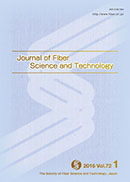
- |<
- <
- 1
- >
- >|
-
Masayoshi Ido, Ryohei Kimura, Haruki Kobayashi, Masatoshi Shioya2019Volume 75Issue 12 Pages 186-192
Published: December 10, 2019
Released on J-STAGE: December 25, 2019
JOURNAL FREE ACCESSThe fatigue mechanism of high-strength fibers from liquid crystalline polymers such as poly(p-phenylene-2,6-benzobisoxazole) (PBO) and poly(p-phenylene terephthalamide) is considered to be completely different from that of general-purpose plastics because of the microfibrillar fiber structure of the former. The present paper investigates the progress of fatigue damages for the PBO fiber based on a structure analysis using the synchrotron radiation small-angle X-ray scattering and the measurement of the axial compression strength. The result indicated that tensile fatigue continues because of the gradual splitting of the microfibrils. Hence, the axial microvoid length increases, and theaxialcompressionstrength decreases.Moreover, an equationhas been proposedforthesingle-fiber axial compression strength of this fiber type, which fails along with the formation of kink band.
View full abstractDownload PDF (3010K) -
Takeshi Namikoshi, Kazuhito Hisada, Toshikazu Sakaguchi, Tamotsu H ...2019Volume 75Issue 12 Pages 193-199
Published: December 10, 2019
Released on J-STAGE: December 25, 2019
JOURNAL FREE ACCESSThe successful grafting of controlled-molecular-weight hydrophilic formyl-terminated poly(vinyl ether)s (poly(VE)s) onto chitosan is reported herein. As the chitosan-graft-poly(ethyl vinyl ether) [poly(EVE)] was not completely soluble in the NMR solvent, the degree of substitution could not be determined by 1H NMR spectroscopy. In contrast, synthesis of the chitosan-graft-poly(ethoxyethyl vinyl ether) [poly(EEVE)] was less efficient (degree of substitution being 0.3), but the obtained graft copolymers were soluble in water, and the lower critical solution temperature was determined to be ~35 ̊C. Thus, functional chitosan materials were successfully developed by grafting thermoresponsive formyl-terminated poly(EEVE) onto chitosan.
View full abstractDownload PDF (2281K) -
Akemi Yasukawa, Keiko Gotoh2019Volume 75Issue 12 Pages 200-208
Published: December 10, 2019
Released on J-STAGE: December 25, 2019
JOURNAL FREE ACCESSCerium-calcium hydroxyapatite (CeCaHap) solid solution particles were prepared with Ce/(Ce + Ca) = 0.01 by a wet method. The obtained particles were supported on cellulose film and cotton fabric by immersing them into the dispersion containing the particles. The morphology and ultraviolet (UV) shielding properties of the substrates supported by CeCaHap were investigated. The UV shielding properties of them were improved after the supporting and were further enhanced by pre-treatment using cationizing agent for both the substrates. The UV shielding ability was reduced by washing with water and an SDS solution for cellulose film, but the ability was kept well even after the washing for the cotton fabric. It is believed that the roughness of the surface of the cotton fiber contributes to the good ability.
View full abstractDownload PDF (5438K)
- |<
- <
- 1
- >
- >|